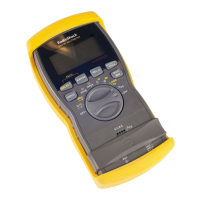Making Measurements
26
Otherwise, to select the duty cycle or pulse
width function, repeatedly press
Hz/DUTY/
WIDTH
until å
åå
å appears (to select duty cycle) or
until µ
µµ
µ
I
II
I or cI
cIcI
cI
appears (to select pulse width)
3. If you are measuring frequency, press
RANGE if
necessary to select manual range then
repeatedly press RANGE until the range you
want appears.
4. Connect the black test probe to a ground
reference for the signal, and connect the red
test probe to the signal source.
/'#574+0)"#%"81.6#)'"(4'37'0%;
The meter can measure the frequency of an AC
voltage, with or without a DC source bias.
Rý
±
1. If you are measuring AC voltage with a DC
source bias, set the function selector to dBm / ~
V
. Otherwise, set the function selector to
°
°°
°
C/
°
°°
°
F /
V.
2. To select the frequency function, repeatedly
press
Hz/DUTY/WIDTH until
Hz
,
kHz
, or
MHz
appears.
3. If necessary, press
RANGE to select manual
range, then repeatedly press
RANGE until the
desired range appears.
4. To select the duty cycle or pulse width function,
repeatedly press
Hz/DUTY/WIDTH until å
åå
å
appears (to select duty cycle) or until
µ
µµ
µ
S
or
mS
appears (to select pulse width).
5. If
å
åå
å, µ
µµ
µ
S
, or
mS
appears and you want to select
the frequency function again, repeatedly press
Hz/DUTY/WIDTH until
Hz
,
kHz
, or
MHz
appears.
6. Connect the test leads to the device you want
to check.
ý
R
"9#40+0)
ý
R
"
To avoid electrical shock
and damage to the meter,
never try to measure a
frequency of more than 1
kHz between AC 40 volts
RMS and 750 volts RMS.
±
"016'"
±
"
• If the function selector is
set to
dBm / ~ V
and you
want to
set the meter for
maximum sensitivity
when measuring a new
signal, press
SELECT
to
select the ACV function
then press
Hz/DUTY/
WIDTH
to select the
frequency function.
• To change back to ACV
measurement, press
SELECT
once then
repeatedly press
SELECT
to select the
ACV display mode (dBm
or volts).
22-812.fm Page 26 Monday, April 8, 2002 1:32 PM

